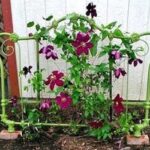Are you looking to start your own vegetable garden? Planning a well-designed layout is crucial for maximizing space and efficiency. In this article, we will explore the benefits of vegetable gardening and discuss the importance of a well-planned garden layout. Additionally, we will provide tips on assessing your space, choosing the right vegetables, and incorporating companion planting and vertical gardening techniques.
Vegetable gardening not only provides fresh and nutritious produce but also offers therapeutic benefits and a sense of accomplishment. A thoughtfully designed layout can make the most of your available space, leading to a successful and bountiful harvest. Whether you are a seasoned gardener or a beginner, finding the right free vegetable garden layout designs can help you achieve your gardening goals.
Assessing your space is the first step in planning your vegetable garden layout. Factors such as sunlight, drainage, and access to water all play a crucial role in determining the success of your garden. By carefully evaluating these aspects, you can ensure that your vegetables have the optimal conditions for growth. Stay tuned as we delve into tips on evaluating these important factors to set yourself up for success in your gardening endeavors.
Assessing Your Space
When planning a vegetable garden, one of the first steps is assessing the available space. This includes evaluating factors such as sunlight, drainage, and access to water. Properly assessing these elements will contribute to the success of your garden in the long run.
Sunlight
The amount of sunlight your garden receives is crucial to the growth and development of your vegetables. Most vegetables require at least 6 hours of direct sunlight each day. Take note of which areas in your yard receive full sun, partial shade, or full shade throughout the day. Keep in mind that the sun’s path changes with the seasons, so it’s important to observe these patterns over time.
Drainage
Good drainage is essential for a healthy vegetable garden. Evaluate whether your chosen garden spot tends to hold water after rain or irrigation. To check for proper drainage, dig a hole about a foot deep and fill it with water. If it takes more than 24 hours for the water to drain completely, the area may have poor drainage and measures might need to be taken to improve it.
Access to Water
Another important consideration is access to water for irrigation. Ensure that your chosen site is within reach of a water source, whether it’s a hose or watering can. If you’ll be using sprinklers or soaker hoses, consider how far their reach extends and plan your garden accordingly.
By carefully evaluating these aspects of your space, you can set yourself up for success when designing and planting your vegetable garden.
Choosing the Right Vegetables
When choosing the right vegetables for your garden, it is essential to consider the specific climate and soil conditions of your location. By selecting vegetables that thrive in these conditions, you can ensure a successful and bountiful harvest. Here are some tips for choosing the right vegetables for your garden:
- Research Your Climate: Before selecting which vegetables to plant, research the climate of your region. Some vegetables thrive in cooler temperatures, while others require a warmer climate to grow successfully.
- Soil Considerations: Assess the quality and composition of your soil. Some vegetables prefer well-draining soil, while others can tolerate clay or sandy soil types. Conduct a soil test to determine its pH level and nutrient content.
- Consider Microclimates: Evaluate any microclimates within your garden space. Certain areas may receive more sunlight or have better drainage than others, which can impact the success of different vegetable varieties.
It is also important to choose vegetable varieties that are resistant to common pests and diseases in your area. By selecting disease-resistant and pest-resistant varieties, you can reduce the risk of problems in your garden.
Ultimately, by carefully selecting vegetables that are well-suited to your specific climate and soil conditions, you can set yourself up for a successful and productive gardening experience. Additionally, consider seeking advice from local gardening experts or agricultural extension offices for recommendations on vegetable varieties that perform well in your area.
Designing Your Layout
When it comes to designing the layout for your vegetable garden, there are several options to consider. Each layout has its own advantages and it’s important to choose one that best suits your space, needs, and gardening style. Here are some popular layout options to explore:
- Traditional Rows: This layout involves planting vegetables in straight rows with pathways in between. It is a classic approach that works well for large gardens and allows for easy access for maintenance and harvesting.
- Raised Beds: Raised beds are elevated planting areas that provide good drainage, aeration, and soil depth. They are ideal for small spaces, improve soil quality, and make it easier to control weeds.
- Square Foot Gardening: This method divides the growing area into small square sections, typically one foot by one foot. It maximizes space by eliminating the need for traditional rows and provides an organized and efficient way to grow a variety of vegetables.
No matter which layout you choose, there are tips for maximizing space and efficiency that can be applied to all. Consider utilizing trellises or vertical supports for vining plants such as cucumbers or beans to save ground space. Additionally, interplanting compatible crops can help maximize yield while deterring pests.
It’s important to carefully plan out your garden layout before planting to ensure proper spacing between crops for optimal growth. Make use of free online resources that offer downloadable templates and planning tools to assist you in creating the perfect vegetable garden design for your space. With thoughtful planning and consideration of different layout options, you can create a bountiful vegetable garden that meets your needs and yields a successful harvest.
Companion Planting
Understanding Companion Planting
Companion planting is a gardening strategy that involves planting different types of vegetables together to benefit each other in various ways. This can include deterring pests, maximizing space, improving flavor, and even enhancing the growth of certain plants. By understanding which plants are compatible with one another, gardeners can create a more harmonious and productive garden.
Examples of Compatible Vegetable Combinations
One classic example of companion planting is the combination of tomatoes, basil, and onions. Tomatoes repel pests that commonly affect basil and onions, while the strong aroma of basil can actually improve the flavor of tomatoes. Another popular combination is planting carrots with onions or leeks. The onion family helps to deter carrot flies and aphids while carrots can break up the soil for better growth of the onion family.
Incorporating flowers like marigolds can also be beneficial as they help to repel harmful insects while attracting pollinators like bees and butterflies. Planting beans near corn or squash creates a mutually beneficial relationship as beans provide nitrogen to the soil that benefits the corn and squash plants.
Tips for Successful Companion Planting
When using companion planting in your vegetable garden layout, it’s important to consider factors such as plant spacing, sunlight requirements, and watering needs. Additionally, being aware of incompatible combinations is crucial to avoid hindering the growth or health of certain plants. By carefully planning your companion planting combinations, you can create a healthier and more balanced ecosystem in your garden while reaping the benefits of higher yields and reduced pest problems.
Incorporating Vertical Gardening
Vertical gardening is a concept that involves growing vegetables on a vertical surface, such as a trellis, wall, or fence. This innovative approach to gardening allows for the maximization of space in small garden areas while adding visual interest and aesthetic appeal. By utilizing vertical space, gardeners can grow more plants in a smaller footprint, making it an ideal solution for urban or limited outdoor spaces.
There are numerous ways to incorporate vertical gardening into your vegetable garden layout. Trellises can be used to support climbing vegetables such as cucumbers, tomatoes, and peas, allowing them to grow upward rather than spreading out along the ground. Additionally, wall-mounted planters and hanging baskets can be utilized to grow herbs and other compact vegetables vertically. These techniques not only save space but also create an eye-catching display that adds dimension and beauty to the garden.
When implementing vertical gardening techniques, it is important to consider the needs of the plants being grown. Proper sunlight exposure, adequate watering, and structural support are crucial factors to keep in mind when planning a vertical garden layout. Careful consideration should also be given to the weight of the plants and the structures supporting them to ensure safety and stability.
| Vertical Gardening Benefits | Examples of Vertical Garden Plants |
|---|---|
| Maximizes space in small gardens | Cucumbers |
| Adds visual interest and aesthetic appeal | Tomatoes |
| Allows for creative garden design | Peas |
Maintenance and Care
Maintaining a healthy vegetable garden involves regular care and attention to ensure that your plants thrive and produce a bountiful harvest. Watering is an essential task, and it is important to water your garden deeply and consistently, ensuring that the soil is moist but not waterlogged. Most vegetables require about 1-2 inches of water per week, so be sure to monitor rainfall levels and adjust your watering schedule accordingly.
In addition to adequate watering, fertilizing your vegetable garden is crucial for promoting healthy plant growth and producing flavorful vegetables. Organic options such as compost and mulch are excellent choices for providing essential nutrients to the soil. These natural fertilizers also improve soil structure, retain moisture, and suppress weed growth.
Pest control is another aspect of garden maintenance that should not be overlooked. Inspect your plants regularly for signs of insect damage or disease, and take prompt action to address any issues. Natural remedies such as introducing beneficial insects or using homemade sprays can help keep pests at bay without resorting to harsh chemicals.
Finally, crop rotation is a key maintenance practice that can help prevent soil depletion and reduce the risk of pest infestations. Rotating crops annually helps maintain soil fertility by alternating nutrient needs among different plant families while minimizing the buildup of pests and diseases associated with specific crops.
| Maintenance Tasks | Tips |
|---|---|
| Watering | Water deeply but do not overwater; monitor weekly rainfall. |
| Fertilizing | Use organic options like compost and mulch for essential nutrients. |
| Pest Control | Regularly inspect plants; use natural remedies when possible. |
| Crop Rotation | Rotate crops annually to maintain soil fertility & minimize pests/diseases. |
Remember to include all relevant information in each sectionaiton including necesary headingscolumnsattributes/measurementsETC.
Additional Resources
In conclusion, designing a well-planned vegetable garden layout is essential for a successful and productive harvest. By carefully assessing your space, choosing the right vegetables for your climate and soil conditions, and incorporating design elements such as companion planting and vertical gardening, you can create a garden that not only looks beautiful but also yields an abundance of healthy produce.
Furthermore, maintaining the garden with proper care including watering, fertilizing, pest control, and crop rotation is crucial to ensure the longevity of your vegetable garden. Additionally, taking advantage of free online resources for vegetable garden layout designs can provide valuable templates and planning tools to help you make the most of your available space while creating an organized and efficient garden.
By using these resources in conjunction with the tips provided in this article, you can create a thriving vegetable garden that will not only bring joy and satisfaction but also provide nourishing food for you and your family. Whether you are a seasoned gardener or just starting out, having a well-designed layout will set you on the path to success in growing your own fresh vegetables. Happy gardening.
Frequently Asked Questions
What Is the Best Layout for a Vegetable Garden?
The best layout for a vegetable garden depends on factors such as the available space, sunlight exposure, and the types of vegetables you want to grow. Generally, it is recommended to arrange crops in rows or blocks with enough space between them for easy access and proper growth.
Taking into account the needs of each plant regarding soil, water, and sun is essential for a successful vegetable garden layout.
What Vegetables Should Not Be Planted Together?
Some vegetables should not be planted together due to their incompatible growing conditions or potential for disease spread. For instance, planting members of the brassica family (like cabbage and broccoli) near nightshades (such as tomatoes and peppers) can lead to increased pest problems.
It’s important to research companion planting and crop rotation to avoid potential issues with incompatible vegetable combinations.
How Do I Plan My Garden Layout?
Planning a garden layout involves considering factors such as the size and shape of the garden area, the specific needs of different types of vegetables, and any existing structures like fences or sheds that may dictate where plants can be placed. It’s also important to consider accessibility for watering, weeding, and harvesting.
Using graph paper or a garden planning tool can help visualize different layout options before finalizing your plan.

Welcome to my gardening blog! I am passionate about plants and enjoy sharing my knowledge and experiences with others. In this blog, I will write about everything related to gardening, from tips on how to get started to updates on my own garden projects.





